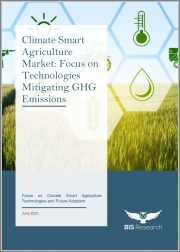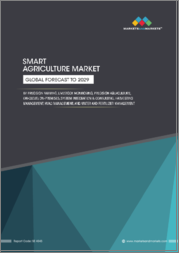
|
시장보고서
상품코드
1308025
기후 스마트 농업(CSA) 시장 : 온실가스 감축 기술 주목Climate Smart Agriculture Market - Focus on Technologies Mitigating GHG Emissions |
||||||
기후 변화, 식량 안보, 농업 관행은 복잡한 관계를 가지고 있으며, 이 다면적인 문제를 해결하기 위해서는 농부, 정책 입안자, 연구자들이 서로 협력해야 합니다.
이러한 이해관계자들은 배출량 감축, 기후 회복력 및 적응력 강화, 농업 생산성 향상을 동시에 달성하기 위한 전략을 적극적으로 추진하고 있으며, CSA의 도입은 이 과정에 내재된 시너지 효과와 상충관계를 고려하면서 이러한 상호 연관된 목표를 효과적으로 추구할 수 있는 종합적인 접근법으로 부상하고 있습니다.
본 보고서는 기후 스마트 농업(CSA, Climate Smart Agriculture) 시장을 조사했으며, 기후 변화와 농업에 미치는 영향, CSA 관련 각종 기술 현황, 각 이해관계자에 대한 제안, 향후 로드맵 등을 정리했습니다.
목차
제1장 기후 변화와 농업에 대한 영향
- 농업에서의 기후 변화 원인
- 농장 게이트 배출량
- 임업
- 에너지 사용
- CSA 도입
제2장 기후 스마트 농업(CSA) : 기술 상황
- 정밀농업
- 정밀농업 도입에 의해 기대되는 배출 감축량
- 보수적인 농업
- 농림업
- 가축 관리
- 재생에너지
- 물 관리
- 기후 정보 서비스
- 정부의 주요 이니셔티와 영향
- 세계의 자금 공급
- 정부 자금 투입
- 민간 자금
- CSA 도입에서의 주요 과제
- 고액의 초기 비용
- 인프라와 CSA의 장점에 대한 인식 부족
제3장 제안 및 결론
- 정책 입안자에 대한 제안
- 기술 제공업체에 대한 제안
- 결론 : 향후 로드맵
제4장 조사 방법
LSH 23.07.20“BIS Research Study Highlights Climate Smart Agriculture Market.”
Introduction
The intricate relationships between climate change, food security, and agricultural practices underscore the need for collaborative endeavors among farmers, policymakers, and researchers to tackle this multifaceted challenge. These stakeholders are actively deploying strategies that concurrently mitigate emissions, enhance climate resilience and adaptation, and improve agricultural productivity. The adoption of climate smart agriculture (CSA) practices has emerged as a comprehensive approach to effectively pursue these interconnected objectives, taking into account the synergies and trade-offs inherent in the process.
Market Introduction
As defined by the United Nations Food and Agriculture Organization (FAO), climate smart agriculture (CSA) is an agricultural framework that offers guidance to farmers in adopting environmentally sustainable and climate resilient practices. This approach goes beyond traditional farming methods and takes an integrated approach to landscape management, including cropland, livestock, forests, and fisheries. It aims to effectively address the interconnected issues of food security and climate change. The applicability of CSA extends to countries across both the Global South and Global North, although regional contexts may result in variations in specific challenges and the prioritization of objectives.
Market Challenges:
The implementation of climate smart agriculture practices can pose financial challenges for farmers, as it often involves significant upfront costs associated with acquiring new technologies and infrastructure. Furthermore, the adoption of precision farming techniques requires investments in specialized equipment and training. However, despite these initial financial barriers, it is crucial to provide support for the adoption of climate smart agriculture practices due to their long-term advantages, such as enhanced crop yields and improved environmental sustainability.
Farmers who possess limited practical knowledge about climate smart agriculture (CSA) and are primarily motivated by economic incentives may exhibit reluctance toward adopting CSA practices. This resistance to change or aversion to risk can hinder their willingness to embrace CSA. The lack of practical understanding refers to limited awareness among farmers regarding the environmental consequences associated with conventional agricultural practices and the potential advantages offered by CSA.
The limited connectivity in marginalized areas poses a significant challenge in terms of accessing real-time data, weather forecasts, and market information essential for the effective implementation of climate smart agriculture (CSA) techniques. Bridging the infrastructure gap becomes imperative to ensure equitable access to information and resources, thereby facilitating broader adoption of CSA practices in these underserved regions.
How Can This Report Add Value to an Organization?
Primary Research
The primary sources involve the climate smart agriculture industry experts and stakeholders such as data suppliers, platform developers, and service providers. Respondents such as vice presidents, CEOs, marketing directors, and technology and innovation directors have been interviewed to verify this research study's qualitative and quantitative aspects.
The key data points taken from primary sources include:
- understanding the competitive landscape
- validation of the numbers of various markets for market type
Secondary Research
This research study involves the usage of extensive secondary research, directories, company websites, and annual reports. It also makes use of databases, such as Hoovers, Bloomberg, Businessweek, and Factiva, to collect useful and effective information for an extensive, technical, market-oriented, and commercial study of the global market. In addition to the aforementioned data sources, the study has been undertaken with the help of other data sources and websites, such as www.fao.org and www.worldbank.org.
Secondary research was done to obtain crucial information about the industry's value chain, revenue models, the market's monetary chain, the total pool of key players, and the current and potential use cases and applications.
Table of Contents
1 Climate Change and its Impact on Agriculture
- 1.1 Cause of Climate Change on Agriculture
- 1.1.1 Farm-Gate Emissions
- 1.1.1.1 Livestock
- 1.1.1.2 Crop Production
- 1.1.2 Forestry
- 1.1.3 Energy Use
- 1.1.1 Farm-Gate Emissions
- 1.2 Implementation of Climate Smart Agriculture (CSA)
2 Climate Smart Agriculture - Technology Landscape
- 2.1 Precision Agriculture
- 2.1.1 Expected Emission Reduction with Precision Agriculture Adoption
- 2.1.1.1 Patent Analysis
- 2.1.1.2 Key Technologies and Providers
- 2.1.1.3 Case Study
- 2.1.1.3.1 Climate Smart Agriculture Case Study by Government of India
- 2.1.1.3.2 Monarch Tractor Wente Vineyards Energy Case Study
- 2.1.1.3.3 Yield Monitoring and Digitization Case Study
- 2.1.2 Conservative Agriculture
- 2.1.2.1 Expected Emission Reduction with Conservative Agriculture Adoption
- 2.1.2.2 Patent Analysis
- 2.1.2.3 Key Technologies and Providers
- 2.1.2.4 Case Study
- 2.1.2.4.1 Soil Erosion Case Study
- 2.1.2.4.2 Sustainable Agriculture Land Management Case Study
- 2.1.3 Agroforestry
- 2.1.3.1 Expected Emission Reduction with AgroForestry Adoption
- 2.1.3.2 Patent Analysis
- 2.1.3.3 Key Technologies and Providers
- 2.1.3.4 Case Study
- 2.1.3.4.1 Climate Smart Forestry Case Study - Wageningen University & Research
- 2.1.4 Livestock Management
- 2.1.4.1 Expected Emission Reduction with Livestock Management Technologies Adoption
- 2.1.4.2 Patent Analysis
- 2.1.4.3 Key Technologies and Providers
- 2.1.4.4 Case Study
- 2.1.4.4.1 Mongolia Livestock Farming Case Study
- 2.1.4.4.2 Livestock Monitoring and Management Case Study
- 2.1.5 Renewable Energy
- 2.1.5.1 Expected Emission Reduction with Renewable Energy Technology Adoption
- 2.1.5.2 Patent Analysis
- 2.1.5.3 Key Technologies and Providers
- 2.1.5.4 Case Study
- 2.1.5.4.1 Solar Power-Based Microgrid Case Study
- 2.1.5.4.2 Solar Powered Farm Case Study
- 2.1.6 Water Management
- 2.1.6.1 Expected Emission Reduction with Water Management Technology Adoption
- 2.1.6.2 Patent Analysis
- 2.1.6.3 Key Technologies and Providers
- 2.1.6.4 Case Study
- 2.1.6.4.1 Reduction of Input Resources - Zerynth S.p.A. Case Study
- 2.1.6.4.2 Automated Water and Fertilizer Management Case Study
- 2.1.6.4.3 Yield Monitoring and Water Management Case Study
- 2.1.7 Climate Information Services
- 2.1.7.1 Expected Emission Reduction with Climate Information Services Adoption
- 2.1.7.2 Patent Analysis
- 2.1.7.3 Key Technologies and Providers
- 2.1.7.4 Case Study
- 2.1.7.4.1 Severe Weather Case Study
- 2.1.7.4.2 Mongolia Herd Management Climate Information Services Case Study
- 2.1.1 Expected Emission Reduction with Precision Agriculture Adoption
- 2.2 Key Government Initiatives and Impacts
- 2.3 Global Funding
- 2.3.1 Government Fundings
- 2.3.1.1 Government Fundings (Year-on-Year)
- 2.3.1.2 Government Funding (by Country)
- 2.3.1.3 Key Government Fundings Focusing Climate Smart Agriculture Practices
- 2.3.2 Private Funding
- 2.3.2.1 Funding Analysis (Year-on-Year)
- 2.3.2.2 Funding Analysis (by Technology)
- 2.3.2.3 Key Private Funding Focusing on Climate Smart Agriculture Practices
- 2.3.2.4 Key Investors in Climate Smart Agriculture Market, 2022
- 2.3.1 Government Fundings
- 2.4 Key Challenges in CSA Adoption
- 2.4.1 High Upfront Costs
- 2.4.2 Lack of Infrastructure and Awareness of Climate Smart Agriculture Benefits
3 Recommendation and Conclusion
- 3.1 Recommendation for Policymakers
- 3.2 Recommendation For Technology Providers
- 3.3 Conclusion: Future Road Map
- 3.3.1 Expected Farm Consolidation
- 3.3.2 Government Support
- 3.3.3 Expected Demand for Climate Smart Agriculture Contract Services among Small Farms
- 3.3.4 Growing Millennial Populations in Agriculture
4 Research Methodology
- 4.1 Data Sources
- 4.1.1 Primary Data Sources
- 4.1.2 Secondary Data Sources



















